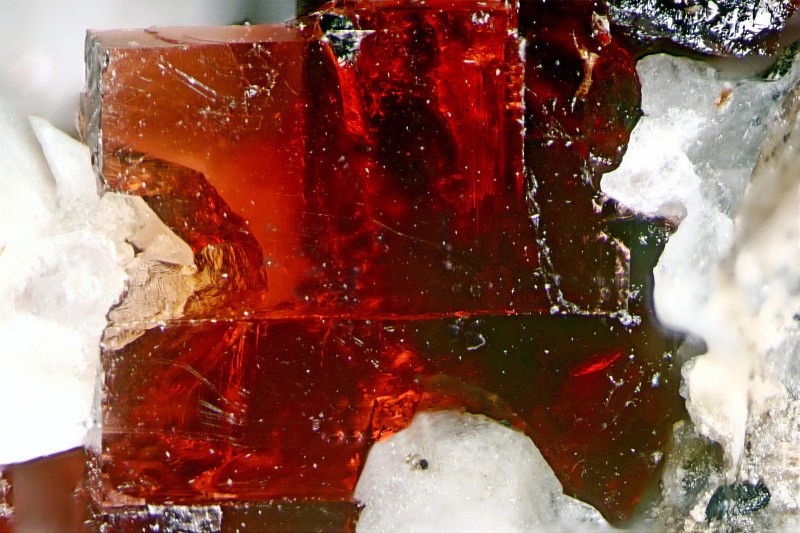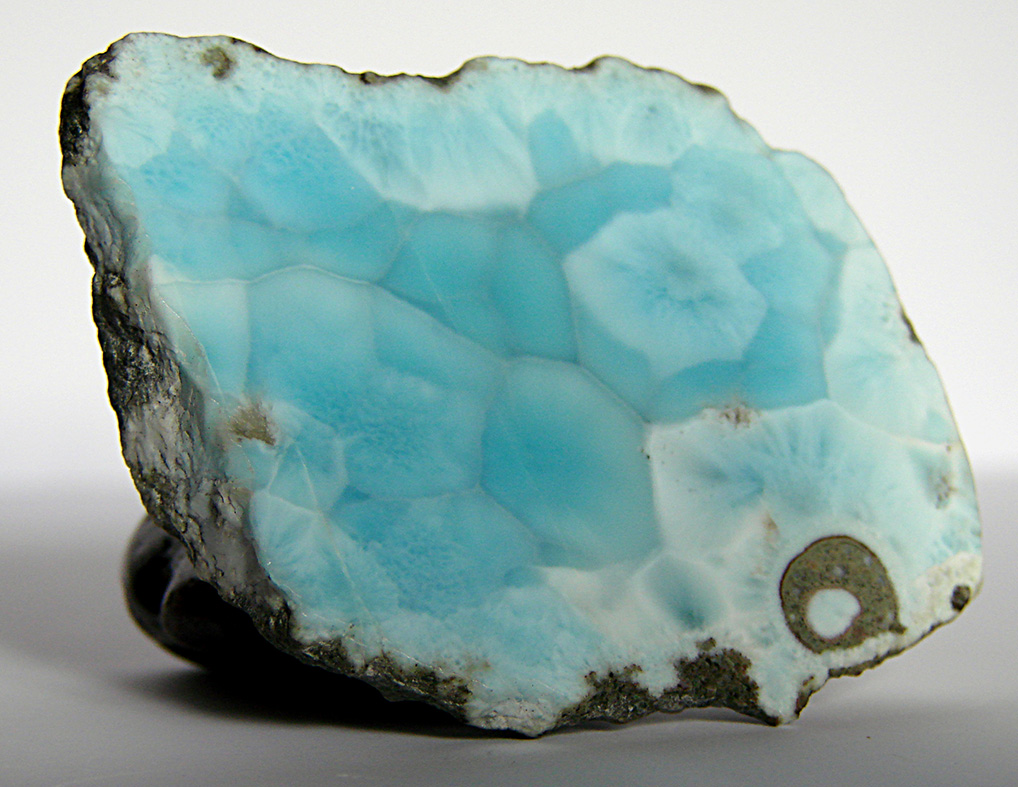|
Fluorcanasite
Fluorcanasite is a rare calcium, potassium, sodium fluoride silicate mineral, discovered in the Kirovsk mine's dumps, in Russia. It has been approved by the IMA in 2007. The name fluorcanasite is a portmanteau word, and was made by blending fluorine, a chemical element that can be found in the mineral, and canasite, as the mineral is close to canasite in several ways (analogue of said mineral and a member of the canasite group). Fluorcanasite is also close to frankamenite. Properties It is the triclinic analogue of canasite, and a member of the canasite group. It grows into prismatic crystals that can reach up to 2 mms in size extending along 10 It is pleochroic, meaning the color of the mineral seems to change depending on the axis it is viewed at. It is coloured amber, purple and lilac respectively along the α, β and γ optical axes. It has a barely detectable 0.77% potassium radioactivity measured by the GRapi (Gamma Ray American Petroleum Institute Units). It consists ... [...More Info...] [...Related Items...] OR: [Wikipedia] [Google] [Baidu] |
Canasite
Canasite is a mineral whose name is derived from its chemical composition of calcium (Ca), sodium (Na), and silicon (Si). It was approved in 1959 by IMA. Properties It is a relatively rare mineral. It occurs as aggregates in charoite, creating carbochons when contrasted against swirling purple charoite. It is extremely rare for canasite to be faceted. As crystals, it occurs in a size up to 10 cms, but in platy aggregates it can reach up to 20 cms in size. It is also granular. Twinning is usual, and can occur as polysynthetic, which is when multiple twins align in a parallel. It has a barely detectable 1.12% potassium radioactivity based on the GRapi unit (Gamma Ray American Petroleum Institute Units). It consists of mostly oxygen (41.98%), silicon (26.8%) and calcium (15.93%), but otherwise contains sodium (7.31%), potassium (6.22%), which gives its radioactive properties, fluorine (1.51%) and hydrogen (0.24%). There are two varieties of canasite: fluorcanasite and frankameni ... [...More Info...] [...Related Items...] OR: [Wikipedia] [Google] [Baidu] |
Monoclinic
In crystallography, the monoclinic crystal system is one of the seven crystal systems. A crystal system is described by three vectors. In the monoclinic system, the crystal is described by vectors of unequal lengths, as in the orthorhombic system. They form a parallelogram prism. Hence two pairs of vectors are perpendicular (meet at right angles), while the third pair makes an angle other than 90°. Bravais lattices Two monoclinic Bravais lattices exist: the primitive monoclinic and the base-centered monoclinic. For the base-centered monoclinic lattice, the primitive cell has the shape of an oblique rhombic prism;See , row mC, column Primitive, where the cell parameters are given as a1 = a2, α = β it can be constructed because the two-dimensional centered rectangular base layer can also be described with primitive rhombic axes. Note that the length a of the primitive cell below equals \frac \sqrt of the conventional cell above. Crystal classes The table below or ... [...More Info...] [...Related Items...] OR: [Wikipedia] [Google] [Baidu] |
Microcline
Microcline (KAlSi3O8) is an important igneous rock-forming tectosilicate mineral. It is a potassium-rich alkali feldspar. Microcline typically contains minor amounts of sodium. It is common in granite and pegmatites. Microcline forms during slow cooling of orthoclase; it is more stable at lower temperatures than orthoclase. Sanidine is a polymorph of alkali feldspar stable at yet higher temperature. Microcline may be clear, white, pale-yellow, brick-red, or green; it is generally characterized by cross-hatch twinning that forms as a result of the transformation of monoclinic orthoclase into triclinic microcline. The chemical compound name is potassium aluminium silicate, and it is known as E number reference E555. Geology Microcline may be chemically the same as monoclinic orthoclase, but because it belongs to the triclinic crystal system, the prism angle is slightly less than right angles; hence the name "microcline" from the Greek "small slope." It is a fully ordered triclinic ... [...More Info...] [...Related Items...] OR: [Wikipedia] [Google] [Baidu] |
Molybdenite
Molybdenite is a mineral of molybdenum disulfide, Mo S2. Similar in appearance and feel to graphite, molybdenite has a lubricating effect that is a consequence of its layered structure. The atomic structure consists of a sheet of molybdenum atoms sandwiched between sheets of sulfur atoms. The Mo-S bonds are strong, but the interaction between the sulfur atoms at the top and bottom of separate sandwich-like tri-layers is weak, resulting in easy slippage as well as cleavage planes. Molybdenite crystallizes in the hexagonal crystal system as the common polytype 2H and also in the trigonal system as the 3R polytype. Description Occurrence Molybdenite occurs in high temperature hydrothermal ore deposits. Its associated minerals include pyrite, chalcopyrite, quartz, anhydrite, fluorite, and scheelite. Important deposits include the disseminated porphyry molybdenum deposits at Questa, New Mexico and the Henderson and Climax mines in Colorado. Molybdenite also occurs in porphy ... [...More Info...] [...Related Items...] OR: [Wikipedia] [Google] [Baidu] |
Lamprophyllite
Lamprophyllite (named for its lustrous cleavage) is a rare, but widespread mineral Ti-silicate mineral usually found in intrusive agpasitic igneous rocks. Yellow, reddish brown, Vitreous, Pearly. Lamprophyllite formula is (Sr,Ba,K,Na)2Na(Na,Fe,Mn)2Ti[Ti2O2(Si2O7)2[(O, OH,F)2 . Full isomorphic range between lampropyllite and baritollalpropyllite exist. The general crystal-chemical formula for lampropyllite-related minerals can be written as A2[(M1)(M2)2(M3)X2] 5] L2(Si2O7)2O2], where the contents of the O and H sheets are given in square brackets in this order and A = Sr, Ba,K, Na; M1 = Na, Mn2+; M2 = Na, Mn2+, Fe2+, Ca; M3 = Ti, Mn2+, Mg, Fe3+, Fe2+; L = Ti, Fe3+; X = OH, O, F. Lamprophyllite is monoclinic, The mineral also has an orthorhombic polytype In materials science, polymorphism describes the existence of a solid material in more than one form or crystal structure. Polymorphism is a form of isomerism. Any crystalline material can exhibit the phenomenon. Allotropy re ... [...More Info...] [...Related Items...] OR: [Wikipedia] [Google] [Baidu] |
Villiaumite
Villiaumite is a rare halide mineral composed of sodium fluoride, Na F. It is very soluble in water and some specimens fluoresce under long and short wave ultraviolet light. It has a Mohs hardness of 2.5 and is usually red, pink, or orange in color. It is toxic to humans. The red color is due to a broad absorption peaking at 512 nm. It is a result of radiation damage to the crystal. Occurrence It occurs in nepheline syenite intrusives and in nepheline syenite pegmatites. It occurs associated with aegirine, sodalite, nepheline, neptunite, lamprophyllite, pectolite, serandite, eudialyte, ussingite, chkalovite and zeolites. It has been reported from Minas Gerais, Brazil; Mont Saint-Hilaire, Quebec, Canada; the Ilimaussaq complex of Greenland; Lake Magadi, Kenya; Windhoek District, Namibia; the Fen Complex, Telemark, Norway; the Khibiny and Lovozero Massifs, Kola Peninsula, Russia; Porphyry Mountain, Boulder County, Colorado and Point of Rocks Mesa, Colfax County, Ne ... [...More Info...] [...Related Items...] OR: [Wikipedia] [Google] [Baidu] |
Nepheline
Nepheline, also called nephelite (), is a rock-forming mineral in the feldspathoid groupa silica-undersaturated aluminosilicate, Na3 K Al4 Si4 O16, that occurs in intrusive and volcanic rocks with low silica, and in their associated pegmatites. It is used in glass and ceramic manufacturing and other industries, and has been investigated as an ore of aluminium. Description and properties Nepheline crystals are rare and belong to the hexagonal system, usually having the form of a short, six-sided prism terminated by the basal plane. The crystals appear to have more symmetry than they actually possess, but unsymmetrical etched figures produced artificially on the prism faces indicate that the crystals are hemimorphic and tetartohedral, the only element of symmetry being a polar hexad axis. Nepheline is found in compact, granular aggregates, and can be white, yellow, gray, green, or reddish. Its hardness on the Mohs scale is 5.5–6, and its specific gravity 2.60–2.65. ... [...More Info...] [...Related Items...] OR: [Wikipedia] [Google] [Baidu] |
Pectolite
Pectolite is a white to gray mineral, Na Ca2 Si3 O8(O H), sodium calcium hydroxide inosilicate. It crystallizes in the triclinic system typically occurring in radiated or fibrous crystalline masses. It has a Mohs hardness of 4.5 to 5 and a specific gravity of 2.7 to 2.9. The gemstone variety, larimar, is a pale to sky blue. Occurrence It was first described in 1828 at Mount Baldo, Trento Province, Italy and named from the Greek ''pektos'' – "compacted" and ''lithos'' – "stone". It occurs as a primary mineral in nepheline syenites, within hydrothermal cavities in basalts and diabase and in serpentinites in association with zeolites, datolite, prehnite, calcite and serpentine. It is found in a wide variety of worldwide locations. See also *Serandite Serandite is a mineral with formula Na(Mn2+,Ca)2Si3O8(OH). The mineral was discovered in Guinea in 1931 and named for J. M. Sérand. Serandite is generally red, brown, black or colorless. The correct name lacks an accent. ... [...More Info...] [...Related Items...] OR: [Wikipedia] [Google] [Baidu] |
Radioactive
Radioactive decay (also known as nuclear decay, radioactivity, radioactive disintegration, or nuclear disintegration) is the process by which an unstable atomic nucleus loses energy by radiation. A material containing unstable nuclei is considered radioactive. Three of the most common types of decay are alpha decay ( ), beta decay ( ), and gamma decay ( ), all of which involve emitting one or more particles. The weak force is the mechanism that is responsible for beta decay, while the other two are governed by the electromagnetism and nuclear force. A fourth type of common decay is electron capture, in which an unstable nucleus captures an inner electron from one of the electron shells. The loss of that electron from the shell results in a cascade of electrons dropping down to that lower shell resulting in emission of discrete X-rays from the transitions. A common example is iodine-125 commonly used in medical settings. Radioactive decay is a stochastic (i.e. random) ... [...More Info...] [...Related Items...] OR: [Wikipedia] [Google] [Baidu] |





